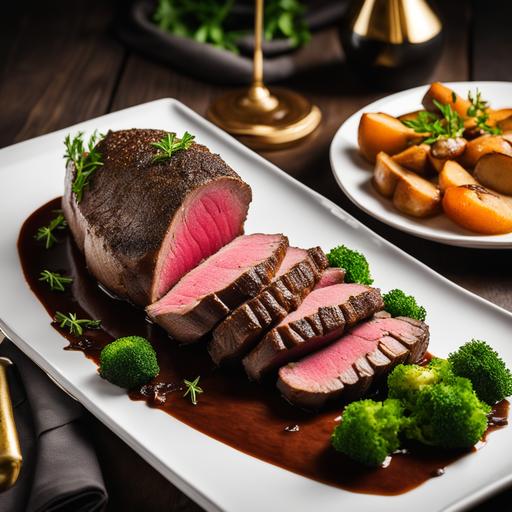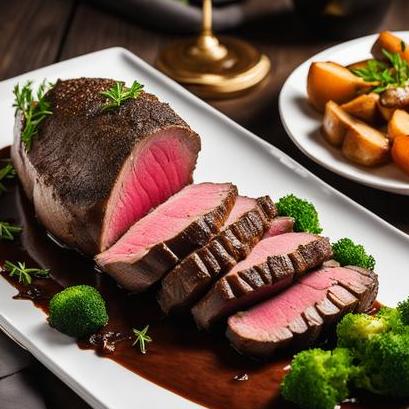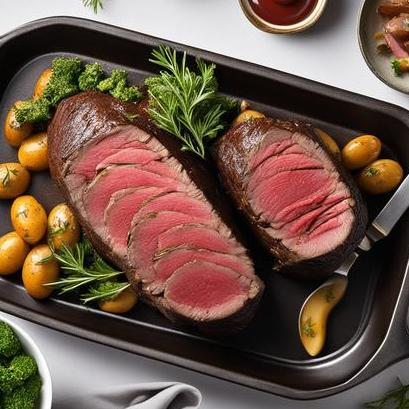
The Art Of Chateaubriand: Mastering The Elegant Oven Recipe
When it comes to refined, gourmet dining experiences, few dishes can rival the sophistication and elegance of a perfectly cooked Chateaubriand. Named after the French author and diplomat François-René de Chateaubriand, this culinary delight is an indulgence that showcases the finest elements of French cuisine. In this comprehensive guide, we will delve into the intricacies of preparing this exquisite dish using an oven, exploring its food science, culinary details, selection, cleaning, preparation, tips, variations, doneness checks, and more. So, let’s embark on a culinary journey to master the art of Chateaubriand!
Food Science and Culinary Details
Chateaubriand is typically crafted from the center-cut portion of a tenderloin, specifically the beef tenderloin roast. This cut of meat, known for its tenderness and succulence, ensures a dining experience that is nothing short of divine. The unique texture and gentle marbling of the tenderloin create an incredibly flavorful and melt-in-your-mouth sensation. Cooking a Chateaubriand in the oven allows for precise control over temperature and heat distribution, enabling you to achieve the desired level of doneness while ensuring a beautifully caramelized exterior.
Selection and Cleaning
Choosing the right beef tenderloin roast is paramount to creating an exceptional Chateaubriand. Opt for a roast that displays vibrant reddish-pink hues and is surrounded by a thin layer of creamy white fat, which adds flavor and moisture during the cooking process. Look for a roast that has minimal connective tissue, ensuring maximum tenderness.
Before cooking, it is essential to properly clean the beef tenderloin roast. Rinse it under cold water to remove any surface impurities, then gently pat it dry with paper towels. This step ensures that your Chateaubriand begins its transformation into a culinary masterpiece with a clean canvas.
Preparation and Tips

-
Bringing the Meat to Room Temperature: Remove the beef tenderloin roast from the refrigerator and allow it to come to room temperature for at least 30 minutes before cooking. This step ensures even cooking throughout the roast.
-
Seasoning: Generously season the tenderloin with kosher salt and freshly ground black pepper, enhancing the natural flavors of the meat.
-
Tying the Roast: To ensure even cooking and a uniform shape, tie the beef tenderloin roast using kitchen twine or butcher’s string. This step also enhances presentation.
-
Preheating the Oven: Preheat your oven to 425°F (220°C). This high temperature will sear and lock in the juices, creating a beautiful crust.
-
Using a Meat Thermometer: Invest in a reliable meat thermometer to accurately monitor the internal temperature of your Chateaubriand. It allows you to achieve the ideal level of doneness – rare, medium-rare, medium, or medium-well – with precision and confidence.
Doneness Checks

Determining the doneness of your Chateaubriand can be a daunting task, but fear not! Follow these guidelines to ensure your Chateaubriand is cooked to perfection:
-
Rare: Achieve a core temperature of 125°F (52°C) for a deep red, warm center.
-
Medium-Rare: Aim for a core temperature of 135°F (57°C) for a pink, warm center.
-
Medium: Reach a core temperature of 145°F (63°C) for a pink center with a hint of warmth.
-
Medium-Well: Attain a core temperature of 155°F (68°C) for a slightly pink center and thoroughly cooked meat.
Recipe: Chateaubriand in the Oven

Ingredients:
-
2 to 3 pounds (900g to 1.4kg) beef tenderloin roast
-
Kosher salt, for seasoning
-
Freshly ground black pepper, for seasoning
-
2 tablespoons (30ml) olive oil
Instructions:
-
Follow the cleaning and preparation steps mentioned earlier.
-
Preheat the oven to 425°F (220°C).
-
Liberally season the beef tenderloin roast with kosher salt and freshly ground black pepper on all sides.
-
Heat olive oil in an oven-safe skillet over high heat until it begins to smoke.
-
Place the beef tenderloin roast in the skillet and sear each side for approximately 2 minutes, until evenly browned.
-
Transfer the skillet to the preheated oven, allowing the Chateaubriand to cook for 15-20 minutes (depending on desired level of doneness).
-
Use a meat thermometer to regularly check the internal temperature, ensuring you achieve the perfect level of doneness.
-
Once cooked to your preference, remove the skillet from the oven and let the Chateaubriand rest for 10 minutes before cutting.
-
Carefully remove the twine and slice the Chateaubriand into thick, luscious medallions.
-
Serve your masterpiece with your choice of sides and sauces.
Overcook and Undercook – A Gourmet Dilemma

The fear of overcooking or undercooking such a prized dish as Chateaubriand can be nerve-wracking. However, with practice and careful attention to internal temperatures, you can navigate this culinary tightrope confidently.
Overcooking this delicacy can result in a loss of tenderness and succulence, drying out the meat and diminishing its glorious flavor. On the other hand, undercooking may leave you with an overly rare or chewy center, failing to highlight the true qualities of a perfectly executed Chateaubriand.
Variations and Explorations
While the classic Chateaubriand recipe will undoubtedly impress your guests, feel free to explore variations and add your personal touch to this culinary gem. Here are some ideas to spark your creativity:
-
Herb-Crusted Chateaubriand: Combine finely chopped fresh herbs like rosemary, thyme, and parsley to create a flavorful crust for your Chateaubriand. Gently press the herb mixture onto the seasoned roast before searing.
-
Mushroom and Truffle Sauce: Elevate your Chateaubriand with a velvety mushroom and truffle sauce. Sauté mushrooms in butter, add a splash of red wine, and finish with a drizzle of truffle oil. Pour the sauce over the sliced medallions—pure heaven!
-
Chateaubriand Wellington: Create a stunning beef Wellington with Chateaubriand as the star. Wrap the seasoned roast in puff pastry with a layer of duxelles (finely chopped mushrooms sautéed with garlic and shallots). Bake until the pastry is golden brown, and the Chateaubriand is cooked to perfection.
The possibilities are endless, so don’t be afraid to experiment and craft your own culinary masterpiece!
Conclusion
Now equipped with this comprehensive guide on cooking Chateaubriand in the oven, you are ready to embark on a culinary adventure that will impress and tantalize your taste buds. Remember, great attention to detail, understanding of the desired levels of doneness, and a touch of creativity can elevate this dish to extraordinary heights. So, don your apron, select the finest beef tenderloin roast, and prepare to indulge in the epitome of gourmet perfection – the Chateaubriand!
Sources
FAQS On Chateaubriand Oven Recipe
What Is A Chateaubriand?
Chateaubriand is a classic French dish made from a beef tenderloin roast that is typically served with a flavorful sauce and side dishes.
How Should I Prepare The Beef Tenderloin For This Recipe?
To prepare the beef tenderloin for this Chateaubriand oven recipe, you should first trim off any excess fat or silver skin. Then, season the meat generously with salt and pepper and sear it in a hot skillet until it is well browned on all sides.
What Kind Of Sauce Should I Serve With This Dish?
The classic sauce for Chateaubriand is a bearnaise sauce, which is made from butter, tarragon, shallots, and vinegar. However, you can also serve the roast with a mushroom sauce, red wine sauce, or any other flavorful sauce of your choice.
What Temperature And Cooking Time Should I Use For This Recipe?
For a Chateaubriand oven recipe, you should preheat your oven to 425°F. Then, roast the beef tenderloin for 20-25 minutes per pound until it reaches your desired level of doneness. Use a meat thermometer to ensure that the internal temperature of the roast reaches 125°F for medium-rare, 135°F for medium, or 145°F for well-done.
What Are Some Good Side Dishes To Serve With Chateaubriand?
Some classic side dishes that pair well with Chateaubriand include roasted or mashed potatoes, sautéed mushrooms, grilled asparagus, and a crisp green salad. You can also pair the dish with a hearty red wine to complement the richness of the beef and sauce.



